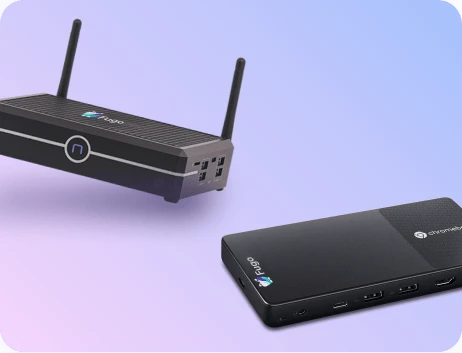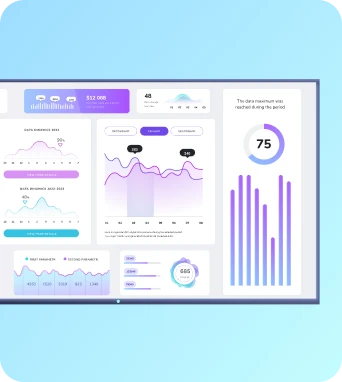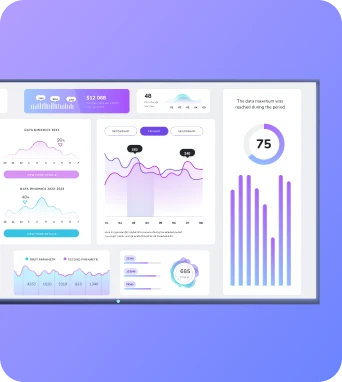Asus Chromebox
Asus Chromebox is a compact Chrome OS-based mini PC often used as a cost-effective digital signage player. In signage contexts it runs a browser-first stack, boots quickly into kiosk or managed sessions, and integrates with cloud signage platforms like Fugo.ai to display playlists, dashboards and HTML5 content reliably across multiple screens.
What is Asus Chromebox?
Performance characteristics and Chrome OS configuration for signage
Asus Chromebox models vary in CPU, RAM and storage, but all share a browser-centric architecture that shapes how signage content is served and rendered. Typical models use Intel Celeron or Core-family processors with integrated graphics and eMMC or SSD storage; these components determine the ceiling for decode performance and the number of simultaneous video layers that can be displayed smoothly. For example, a Chromebox with an Intel Core i3 and 8 GB RAM will handle 1080p H.264 or H.265 streams and multiple HTML5 overlays far more consistently than a base Celeron model with 4 GB. Administrators should evaluate codec support, output resolutions (single versus dual HDMI), and hardware acceleration behaviour, because hardware video acceleration in Chrome OS can significantly reduce CPU load and thermal throttling when playing long-form MP4 files or adaptive HLS streams. On the configuration side, Chrome OS exposes several management controls that are relevant to signage networks. Device enrolment into Google Workspace or a compatible MDM lets operators lock the device into kiosk mode, pin a managed Chrome app or set a URL that launches full-screen on boot. Practical implementation often combines a managed session that disables local sign-in, enforces a device auto-update policy and schedules nightly restarts through the platform’s management console to clear transient memory growth. Inline examples of settings administrators often apply include forcing the browser to open a specific player URL such as https://player.fugo.ai/?device=serial123 and enabling network proxy settings for environments that require upstream filtering. Understanding and testing how Chrome OS handles updates and certificate chains is essential; an unexpected update or a failing root certificate can interrupt playback across an estate, so organisations commonly validate updates on a small pilot group of Chromebox units before wider rollout.
Deployment, monitoring and optimisation for Chromebox signage fleets
Deploying Asus Chromebox devices at scale requires planning for physical mounting, network provisioning and ongoing monitoring. From a practical standpoint, secure mounting brackets and HDMI retention clamps prevent accidental disconnection in high-traffic locations, while PoE-friendly network options or tidy power anchoring reduce service calls. When provisioning, many teams use zero-touch enrolment with Google Admin or an enterprise MDM to push an initial configuration, apply trusted certificates and set the managed browser to kiosk mode. A common deployment workflow with Fugo.ai involves registering each Chromebox device in the Fugo console by serial or device token, assigning a playlist or layout, and then applying a managed URL that points the device at the Fugo player endpoint on first boot. Inline examples include embedding device-specific query parameters in the managed URL to ensure the player fetches the correct configuration, for instance https://player.fugo.ai/?auth=tokenXYZ&device=serial456. Monitoring and optimisation are ongoing tasks. Real-world estates benefit from layered monitoring: operating system health reported via Chrome management, player status and heartbeat metrics from the signage platform, and network-level monitoring for latency and packet loss affecting stream quality. Administrators should configure alerts for missing heartbeats, prolonged high CPU usage or repeated reboots. Common pitfalls include underpowered Wi-Fi environments, captive portals that interrupt initial provisioning, and competing auto-update schedules across devices. To reduce bandwidth spikes and playback interruptions, organisations often enable local caching of assets on SSD, limit simultaneous full-resolution downloads during business hours, and use adaptive bitrate streaming for live feeds. On Fugo.ai and similar platforms, thoughtful scheduling and pre-warming of heavy assets combined with nightly maintenance windows and periodic player restarts keeps Chromebox-based signage fleets predictable and cost-effective.
Final Thoughts on Asus Chromebox
Keep the learning going...
Aspect ratio correction
Aspect ratio correction is the process of adjusting media and layout to match the native width-to-height proportions of a display, using scaling, cropping, padding or letterboxing. In digital signage it prevents distortion, preserves composition and ensures consistent presentation across screens, dashboards and mixed-player networks.
Asset tagging
Asset tagging in digital signage is the systematic application of descriptive labels and structured metadata to media files, templates and playlists to enable targeted scheduling, device-level delivery, automated workflows, analytics and integration with content management systems across signage networks and dashboards.
Asus Chromebox 5
The Asus Chromebox 5 is a compact Chrome OS mini PC designed for enterprise and commercial use, offering modern Intel processors, 4K-capable graphics and multiple I/O options. It’s well suited as a reliable client for digital signage, TV dashboards and kiosks where secure, remotely managed single-purpose playback is required.



